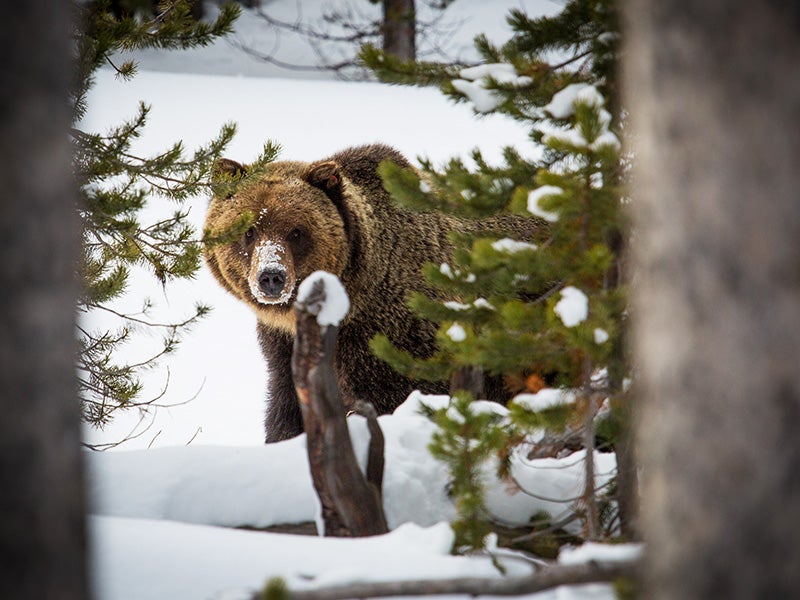Federally Approved “Take” of Grizzly Bears Threatens Recovery
Conservationists demand agency consideration of escalating mortality
Contact
Recent federal approvals for the lethal “taking” of 15 grizzly bears in Grand Teton National Park and the Upper Green River area of northwest Wyoming threaten to push grizzly mortalities beyond sustainable levels in the Yellowstone region, according to conservation groups. Today, those groups gave notice of their intent to file suit to protect the grizzlies.
Today’s Notice of Intent to Sue by the Sierra Club and Western Watersheds Project, represented by the public-interest environmental law firm Earthjustice, challenges the U.S. Fish and Wildlife Service (“FWS”), National Park Service and U.S. Forest Service over their recent decisions allowing the lethal “take” of 15 grizzly bears.
In decisions issued over the past 15 months under the Endangered Species Act, FWS reasoned that approved grizzly killing would remain within sustainable levels. However, FWS, the Park Service and the Forest Service all neglected to consider the fact that the killing of these 15 grizzlies, when added to the amount of other grizzly “taking” anticipated by FWS around the Yellowstone region, could exceed sustainable levels for females by more than three times, pushing the population into decline.
“Killing 15 more bears in the Yellowstone region, including even in one of our nation’s premier national parks, could be the straw that breaks the camel’s—or, in this case, the grizzly’s—back,” said Earthjustice attorney Tim Preso. “The Endangered Species Act requires federal officials to look at that big picture, yet they failed to do so.”
“The Fish and Wildlife Service has repeatedly increased the number of grizzly bears that can be killed, without looking at the broader impact on grizzly recovery in the region. Taken together, the anticipated ‘take’ would exceed the agency’s own limit for female grizzly bear deaths by more than three times,” said Bonnie Rice with Sierra Club’s Our Wild America campaign. “With a slow reproducing animal like the grizzly bear, those numbers would have significant long-term consequences on grizzly recovery.”
“The Fish and Wildlife Service has a responsibility to protect the endangered grizzly bear,” said Travis Bruner, Executive Director of Western Watersheds Project. “The Service continues to allow the killing of more bears without presenting sound scientific reasoning that considers the regional impact on the species. We demand that the government rethink its approach, and base its decisions on science rather than politics and the interests of private livestock owners that graze cattle on our public lands.”
Legal Documents
Background
Yellowstone-area grizzly bears are listed as a threatened species under the Endangered Species Act. Federal biologists acknowledge that the growth of the Yellowstone grizzly bear population level has flattened over the past decade. At the same time, the grizzly population has been faced with the loss of two of its most important food sources in the Yellowstone region—whitebark pine seeds and cutthroat trout—due to changing environmental conditions driven in part by a warming climate. In the wake of these changes, scientists have documented the bears’ transition to a more meat-based diet, but that diet leads to a greater potential for conflict with human hunting and livestock grazing activities.
Against this backdrop, FWS in September 2013 authorized the National Park Service to proceed with an elk hunt in Grand Teton National Park that is anticipated to cause the lethal take of four grizzly bears over a nine-year period. Then, in September 2014, FWS authorized the Forest Service to continue livestock grazing operations in the Upper Green River area of the Bridger-Teton National Forest that are anticipated to cause the lethal take of 11 more grizzly bears within any consecutive three-year period through the end of 2019.
In issuing these decisions, FWS reasoned that these impacts to the Yellowstone-area grizzly population would be acceptable because the anticipated bear mortalities would fall within limits established by federal biologists to ensure a sustainable grizzly population that does not slip into decline. However, FWS failed to acknowledge or consider the fact that the Grand Teton and Upper Green “take” determinations, when combined with similar “take” determinations issued by FWS and currently in effect for other actions around the Yellowstone region, anticipate the killing of as many as 65 female grizzly bears in a single year—a level that more than triples FWS’s own established mortality limit.
The conservationists contend that FWS cannot rely on compliance with sustainable grizzly mortality thresholds to justify additional killing of Yellowstone bears unless federal officials consider the impacts of all the grizzly bear mortality they have anticipated across the region.

Additional Resources
About Earthjustice
Earthjustice is the premier nonprofit environmental law organization. We wield the power of law and the strength of partnership to protect people's health, to preserve magnificent places and wildlife, to advance clean energy, and to combat climate change. We are here because the earth needs a good lawyer.